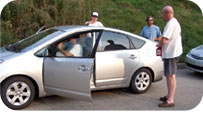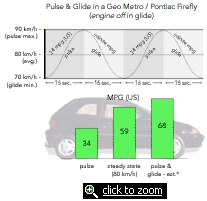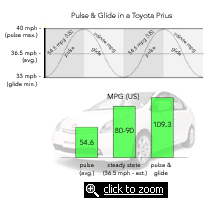Pulse and glide
Pulse and glide works - in theory - on any car.
Pulse & glide overview
Pulse and glide works like this: let's say you're on a road where you want to go 60 km/h. Instead of driving along at a steady 60, you instead accelerate to 70 (that's the pulse), and then coast in neutral with the engine off down to 50 (that's the glide). That's it. Rinse and repeat. And repeat. And repeat...
By doing this, you're still averaging 60 km/h, but it turns out that pulse and glide is significantly more efficient than driving along maintaining a steady 60 km/h.
Why it works

|
The secret is in the glide, and it's is best illustrated by the extreme Prius demonstration.
The Prius is particularly excellent at gliding because under most conditions when the the accelerator is released below 40 mph, the gasoline engine shuts off completely and the transmission effectively freewheels in neutral (it's actually slightly more complicated than that, but stick with me). So, while gliding, it's effectively getting infinite mpg - it's using no gas at all.
For that reason, the marathon drivers picked 40 mph as the upper limit of their pulse & glide cycle (33 mph was the bottom). So in order to achieve 109.3 mpg, they just had to average 54.65 mpg while pulsing gently from 33 - 40 mph. And it turns out, in a Prius, you can. So, assuming equal length pulses & glides, they traveled half the total distance of their trip getting 54.65 mpg, and half the total distance using no fuel at all. It averages out to 109.3 mpg.
Pulse & glide in a Geo Metro
- At a steady 80 km/h (about 50 mph) I was getting 59 mpg (US) (there was a tail wind)
- "gliding" down from 90 to 70 km/h took 16 seconds
- "pulsing" back up from 70 to 90 km/h at a rate of acceleration that also took 16 seconds I was getting about 34 mpg (US)
- So my pulse and glide average would be 68 mpg, vs. 59 at the same average speed. That's a 15% increase over the steady state mpg - theoretically.
I say theoretically because the engine would have to be off in the glide to get that mileage. You could do it, but it adds another step in an already arguably impractical process (remember the engine shuts off automatically in the Prius when you lift off the accelerator).
So I took a couple more readings. With the engine idling, and the car in neutral, the average mpg shown on the ScanGauge in the glide down from 90-70 km/h was 55 mpg.
I would name the difference between the two techniques "full" pulse & glide (neutral, with engine off in the glide) vs. "mild" (neutral, with engine idling in the glide).
So, now you know the next time you find yourself cruising down a lonely road at a steady speed, you're not getting the best mileage you could. You could be pulsing & gliding to maintain the same average speed, and saving lots of fuel in the process.
The Pulse & Glide Workout!
Practical implications
What useful information comes from this for the non-hybrid driver?
- (Okay, the first one is hybrid related...) Toyota ultra-efficient cruise control! The Prius could potentially have a "pulse and glide" cruise control setting to completely automate the cycle. Set your target speed, and the car pulses & glides around it.
- For me, the technique simply underlines the importance of maximizing the amount of "glide" (whether engine on or off) in my driving. In other words, time spent in neutral, or with the clutch depressed. For example, when approaching a stop or a forced speed reduction, rather than maintaining a constant speed as I approach, I now try to execute the optimal pulse that permits me to coast half the distance (or more) with as little braking as possible.
- It causes you to carefully consider the comparitive efficiencies of different ways of accelerating or decelerating. E.G. deceleration efficiency, from best to worst in a non-hybrid (standard liability statement applies - don't do this if it puts you or others at risk): (1) engine off, in neutral (or clutch in); (2) engine idling, in neutral; (3) engine running, in gear (it's true that some cars' fuel injectors shut off when decelerating in gear above a certain engine RPM threshold, but the savings in fuel is cancelled by the faster rate of deceleration from engine braking. Relative to coasting in neutral, it's less efficient.); (4) braking (assumes engine also running, in gear).
- The pulse & glide downside: it stands to reason that the technique is somewhat harder on the machinery (in terms of wear) than simply maintaining a steady speed. This is even more true in "full" pulse & glide mode, if you are repeatedly using the starter to re-start the engine. For that reason alone I'd be reluctant to use it to boost "steady state" (e.g. hwy) mileage. Its benefits are more practically realized in situations where you have to accelerate and decelerate on a regular basis anyway (e.g. sub/urban driving).
| Acceleration on a level road is the same energy-wise (in energy consumed per mile of travel) as climbing a hill at constant speed if the acceleration in g's is equal to the slope of the hill, for example an acceleration of 0.02g is equivalent to climbing a 2% grade. Similarly, decelerating on a level road is the same as coasting down a hill at constant speed. Coasting at constant speed of course will only happen if the downslope is just right; too steep and you will accelerate, too shallow and you will slow. In the glide phase of P&G the time taken to fall from say 44 to 22mph defines the deceleration rate: it would be 1.0g if the time was one second, and .02g if the time taken was 50sec. My HCH takes about 60 seconds on a level road to drop from 44 to 22, so I should be able to coast downhill at constant speed on a downslope of 1/60 or .0167. The problem I have is there are very few level roads around here, especially ones that I can use to dink around at 22mph. So I don't have a strong feeling for the accuracy of that 60 seconds. I do have some pieces of road that I have determined from GPS data have a slope of about .017 and indeed I can coast at nearly constant speed on them. So where is all this leading? Well, I have used my Trip A meter to measure fuel consumption while climbing long hills of various slope and I've found that my fuel consumption is something like FC = B(1+C*S) gallons per mile where B and C are constants and S is the slope (.02 for a 2% grade). B is the fuel consumption you get at constant speed on the level, and C is a number somewhere between 30 and 50. Now let's imagine a P&G session where on a level road we pulse from 22 to 44mph in P seconds and then glide from 44 to 22mph in G seconds. The slope (S) in the equation can be replaced by acceleration (1/P), so the fuel consumed in pulse is B(1+C/P) multiplied by the distance traveled in pulse. The average speed is 33mph, so the distance traveled is 33P/3600. Fuel consumed in glide is zero and the distance traveled is 33G/3600. Taking total fuel used divided by total distance traveled we get FC = B(P+C)/(P+G) gpm You can play with this result but as long as C is numerically less than G you'll get lower FC with very small values of P - meaning hard acceleration is better. You have no choice with G - you get whatever your tire pressure dictates. Finding C is a little tricky because some of the hill climbs I made were assisted by the battery pack. If I started with low SOC I got values of C near the high end of the 30-50 range mentioned above. I would dearly love to hear what others get for G - the number of seconds to glide from 44 to 22mph, and how it depends on tire pressure. You should go both directions to average out wind and slope (if there is any) |
'건강하고 행복하게 > 자동차생활' 카테고리의 다른 글
| Hydraulic Ram Pump (0) | 2014.12.06 |
|---|---|
| Diesel cars vs Gasoline cars (0) | 2014.05.30 |
| Pulse and Glide, Burn and Coast (0) | 2014.05.26 |
| Fuel Efficiency by Coasting in the Vehicle (0) | 2014.05.25 |
| ECONOMICAL OPERATION (0) | 2014.05.25 |

